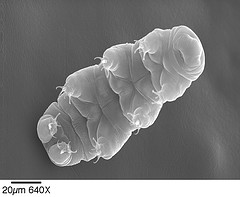
Habitat
Geographically, H. dujardini is distributed
globally, though specifically they call moss and lichen or
freshwater habitats home. However tardigrades as a whole are not
limited to those conditions. They can be found in marine and
brackish water, freshwater, or limnoterrestrial (dry and aquatic
conditions) environments. To live terrestrially, these animals are
usually in a moist environment where refuge such as moss, lichen,
liverworts, etc. are prevalent since there’s less likelihood of
dehydration (Shaw 2011). Most
tardigrades are terrestrial, where they’re inactive unless covered
by the vital film of water.
Cousins of H. dujardini, the H. klebelberg, H.
janetscheki, and H. thaleri have been found in cryoconite holes,
which are holes in glaciers derived from heat being absorbed where
dark dust has accumulated. Additionally, species of tardigrade were
also found in sediment layers (Thorp et. al
2010). Given all these incredible examples, it can be concluded
that their niche is not limited to a single habitat in regards to
climate for the phyla, something that not many other organisms can
claim.
As a whole, for a good tardigrade habitat, they
require: a sufficient air flow source so that oxygen won’t be
lacking within their water film, alternate wet and dry conditions,
and enough food to keep them active--they eat 43% of their body mass
daily! (Thorp et. al 2010). Granted,
these conditions are near universal in the animal kingdom, but not
usually in such a general context, for the tardigrades are truly
ubiquitous.

Home


